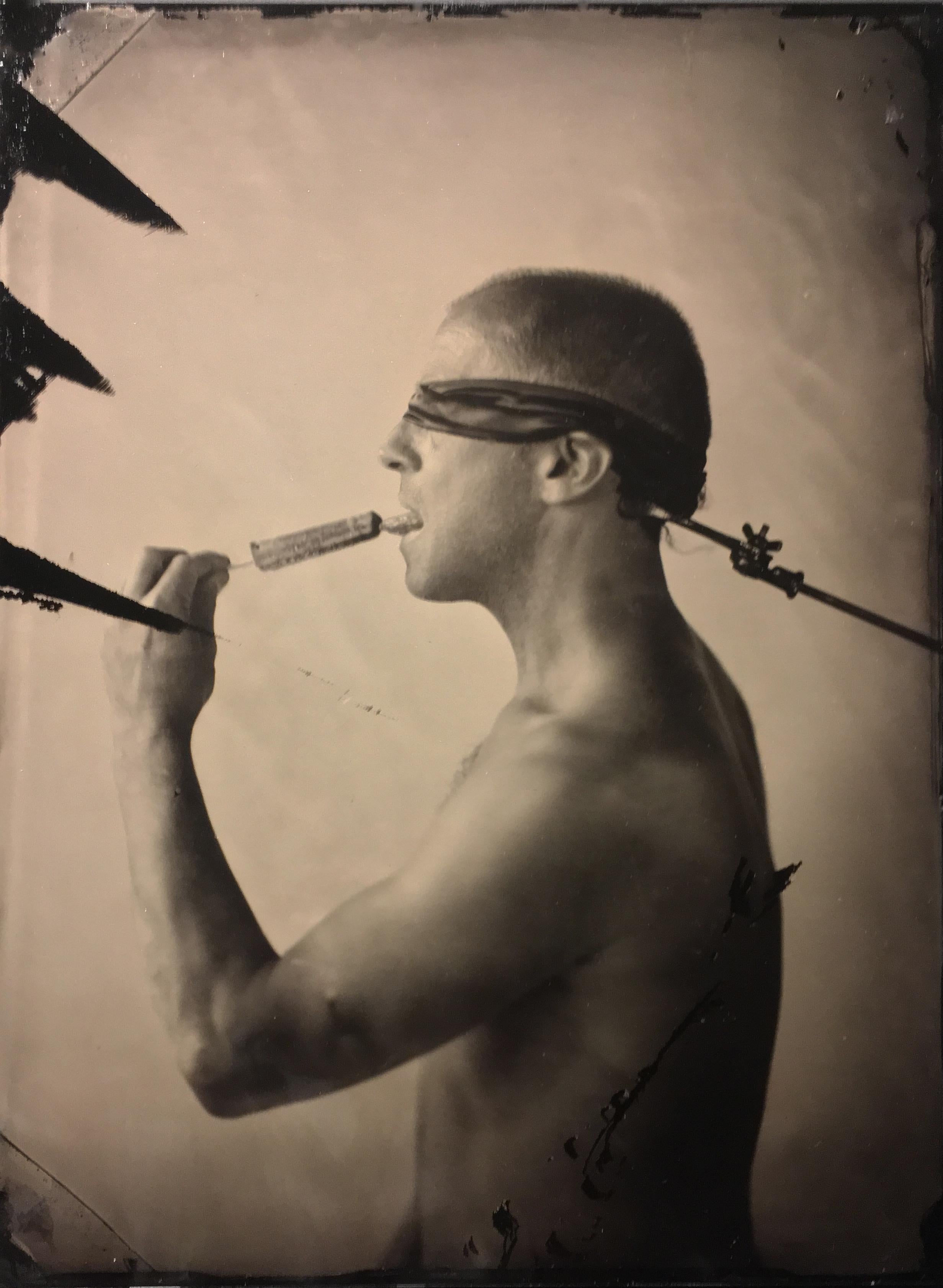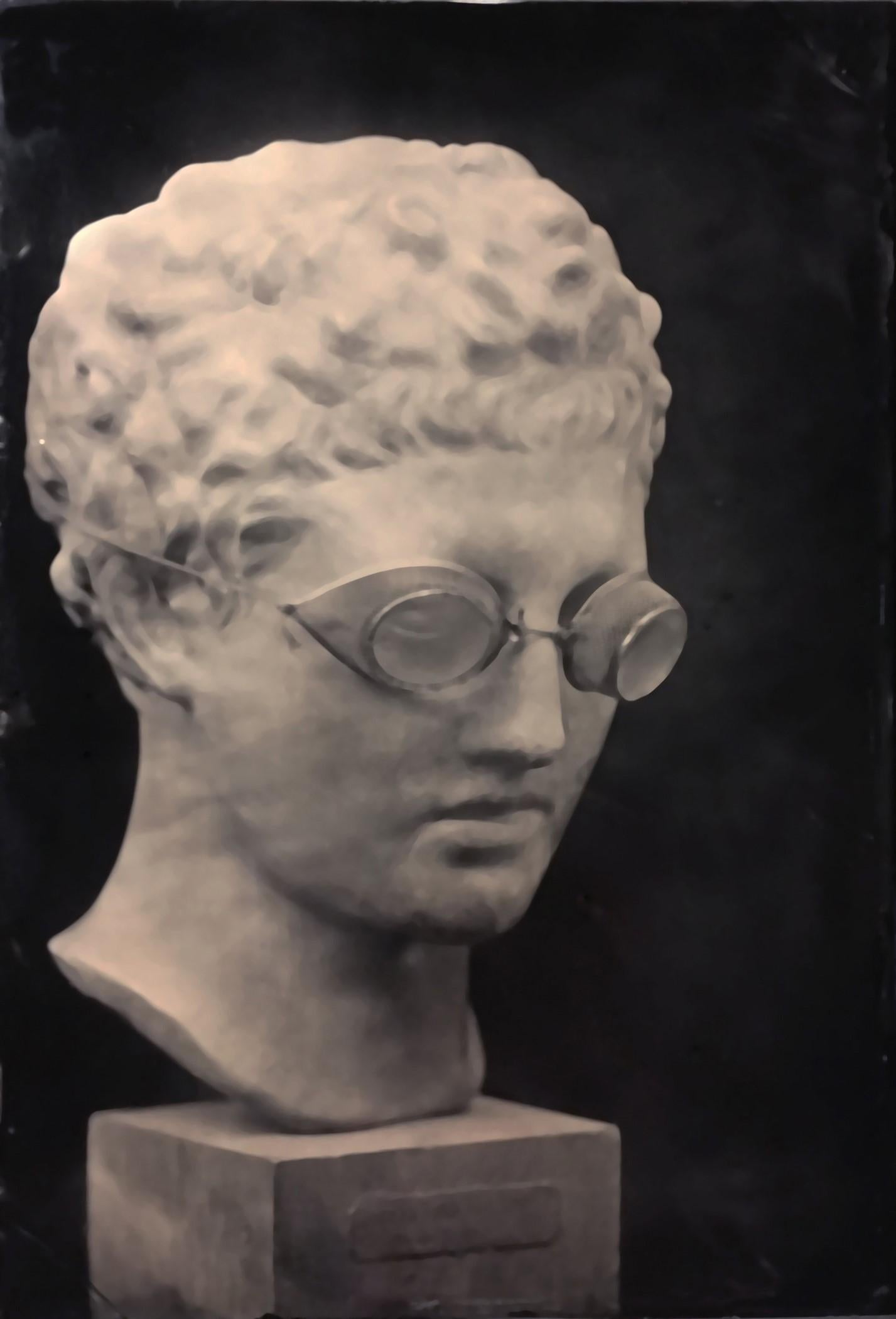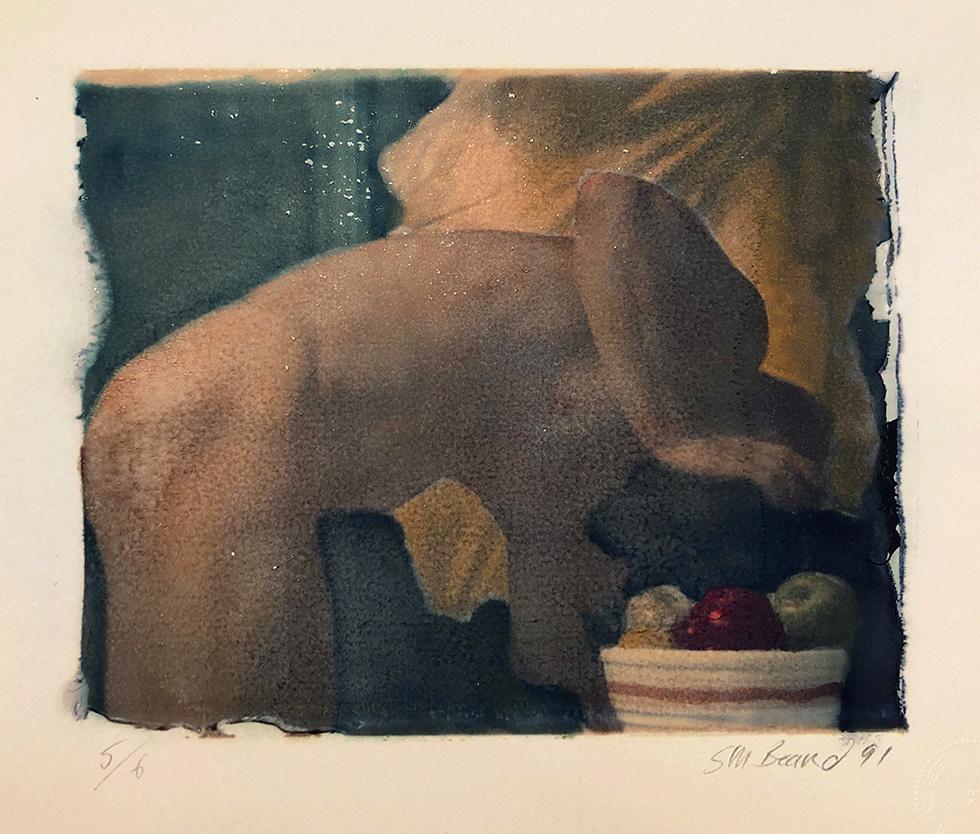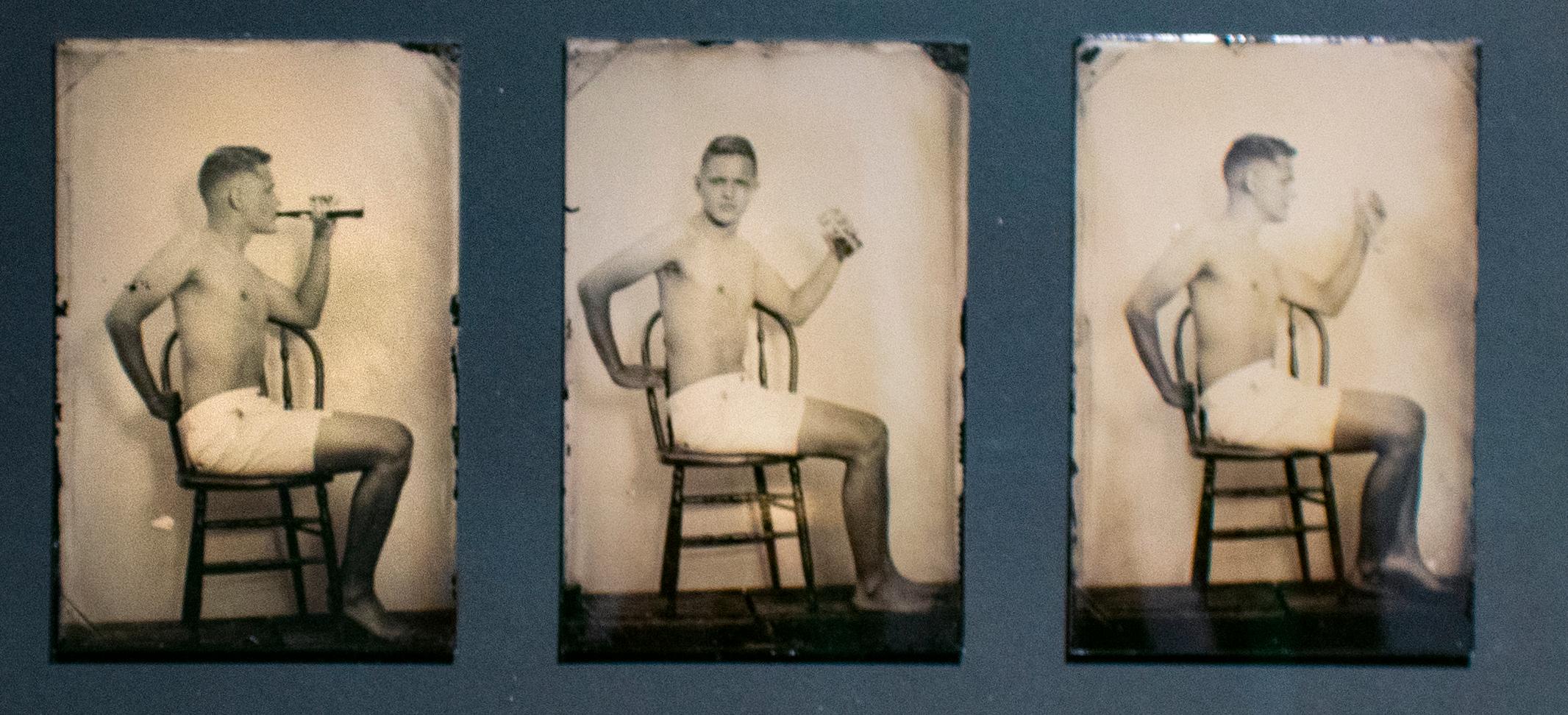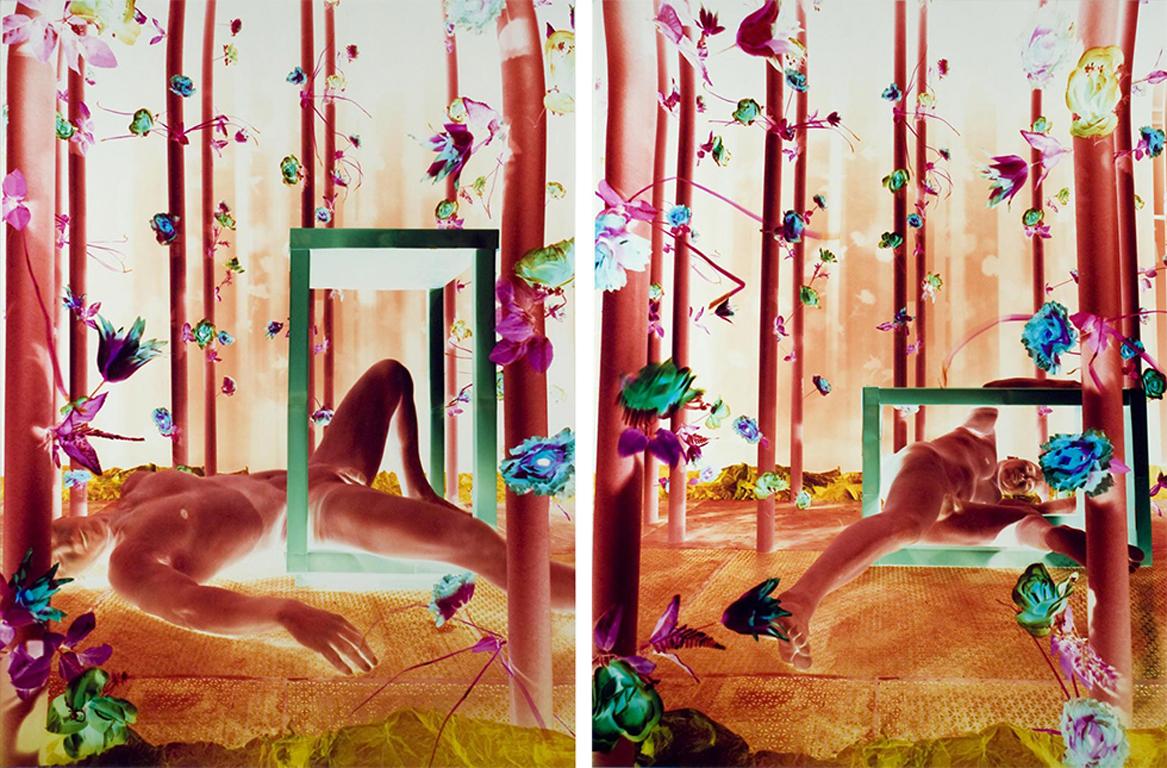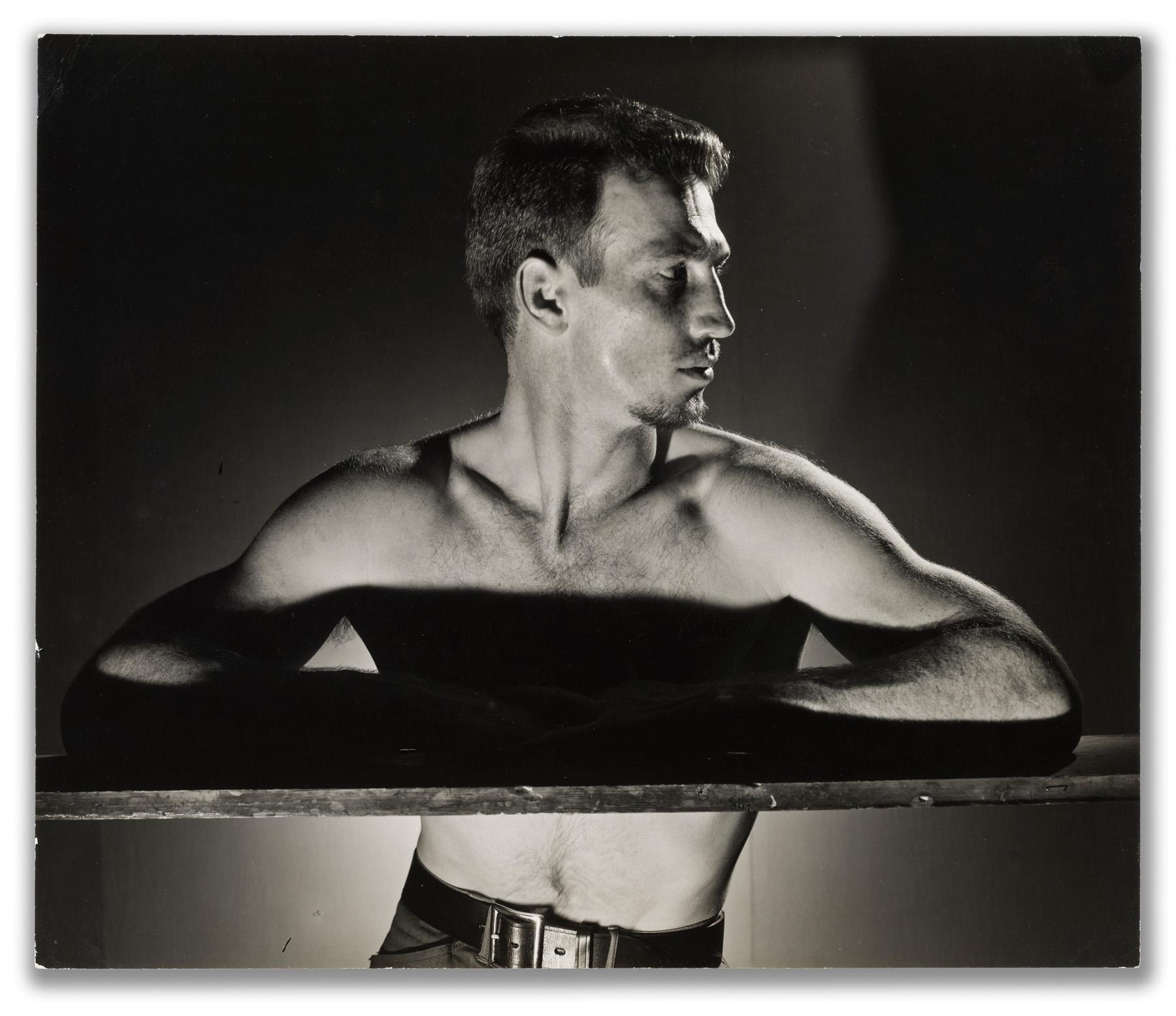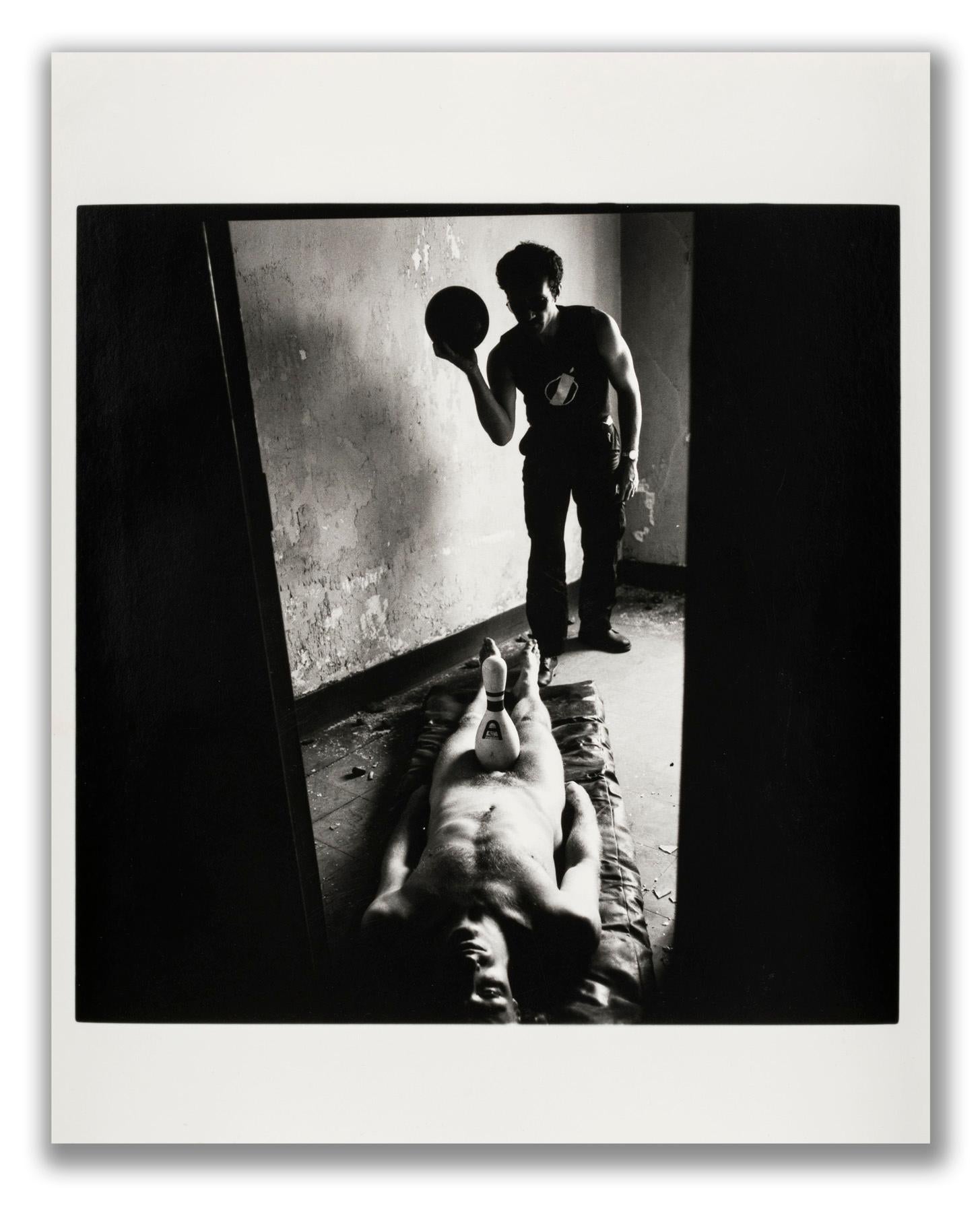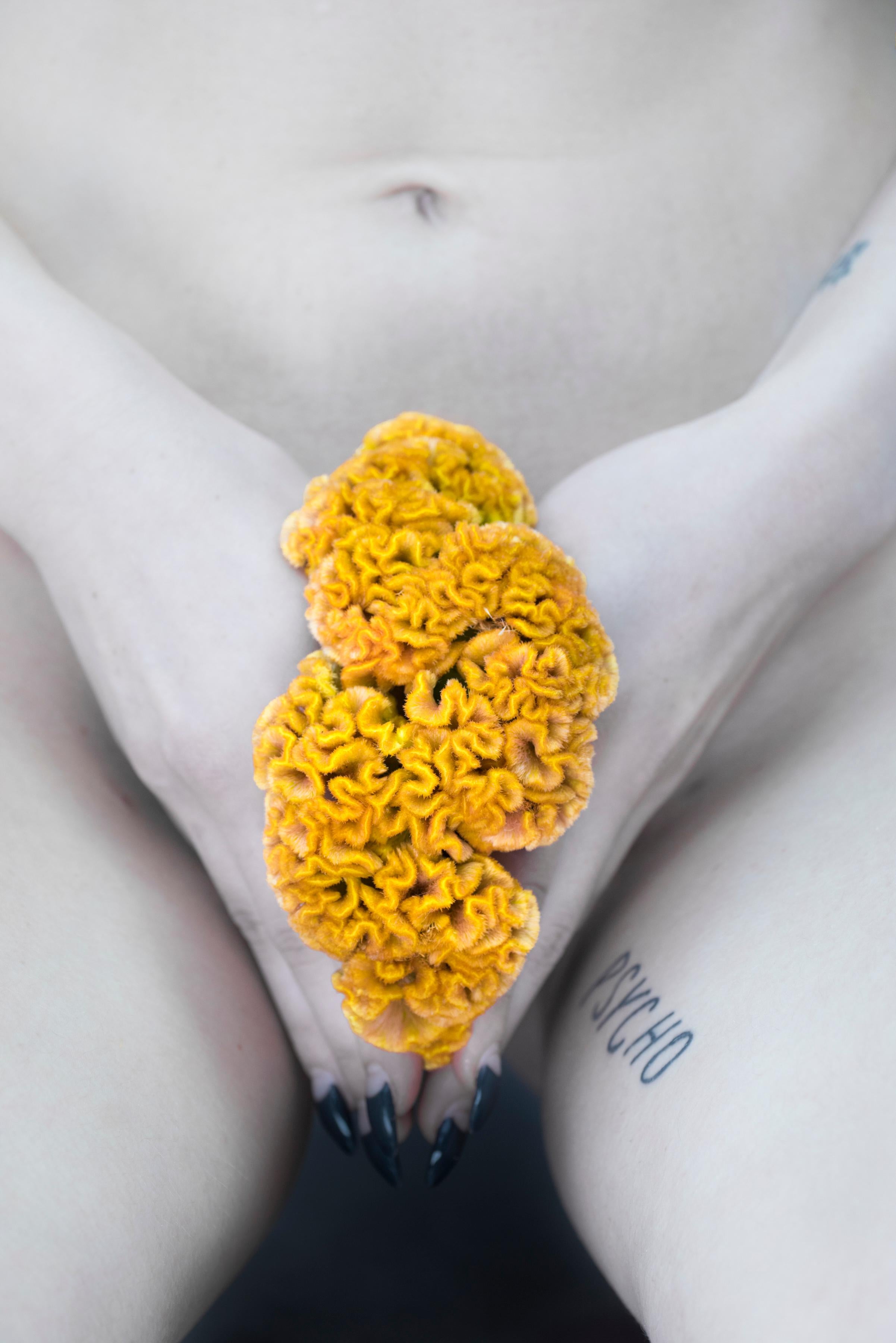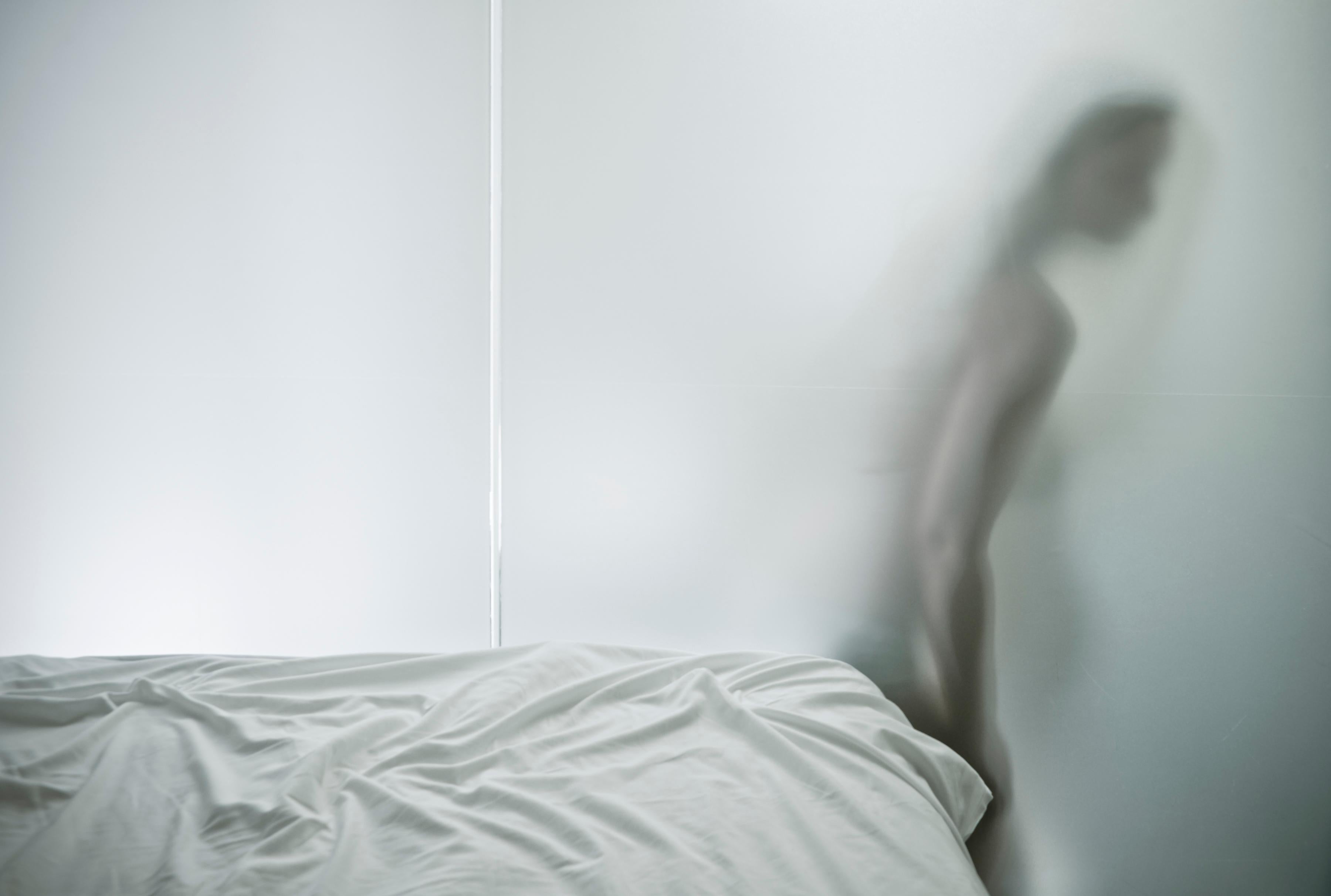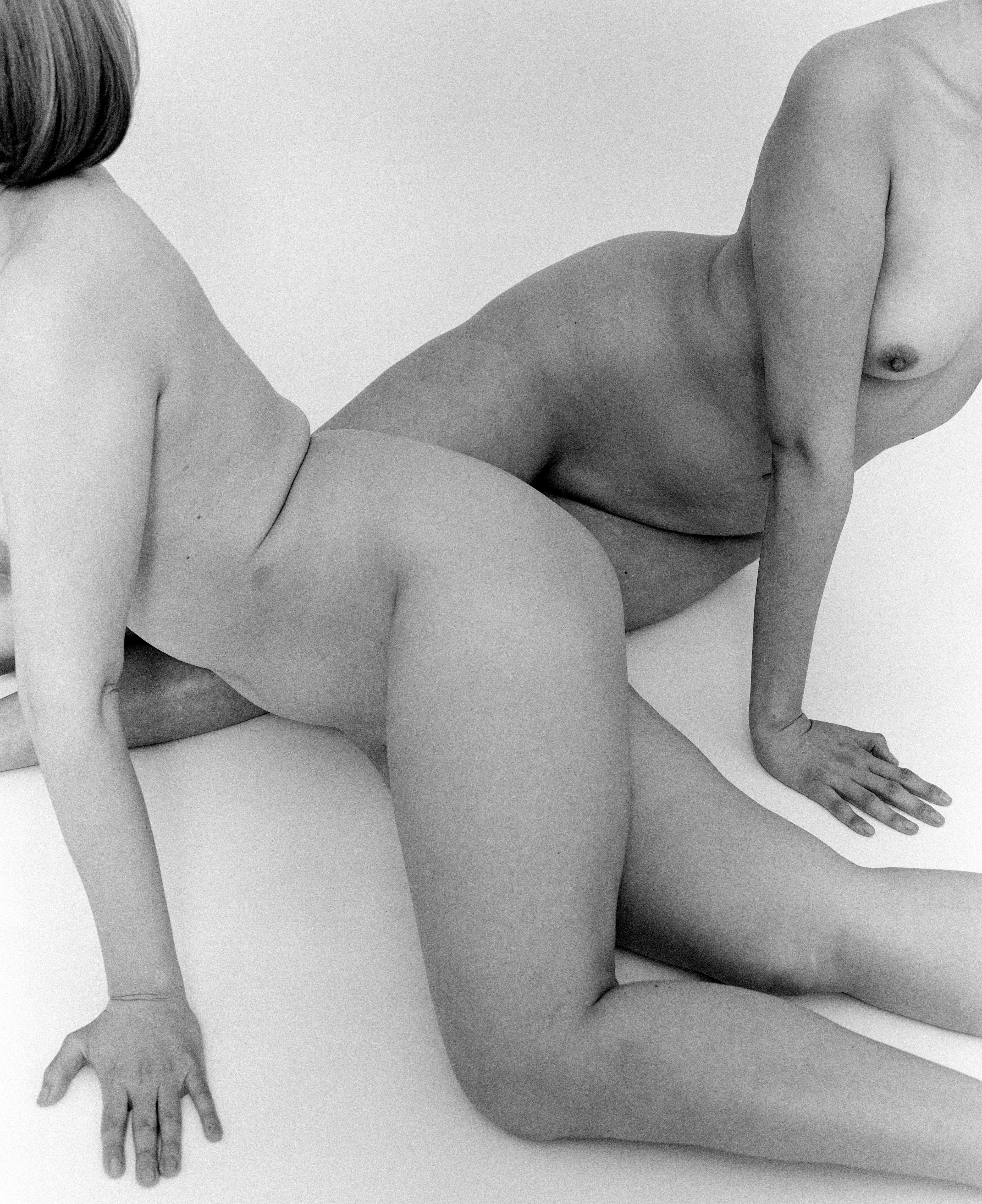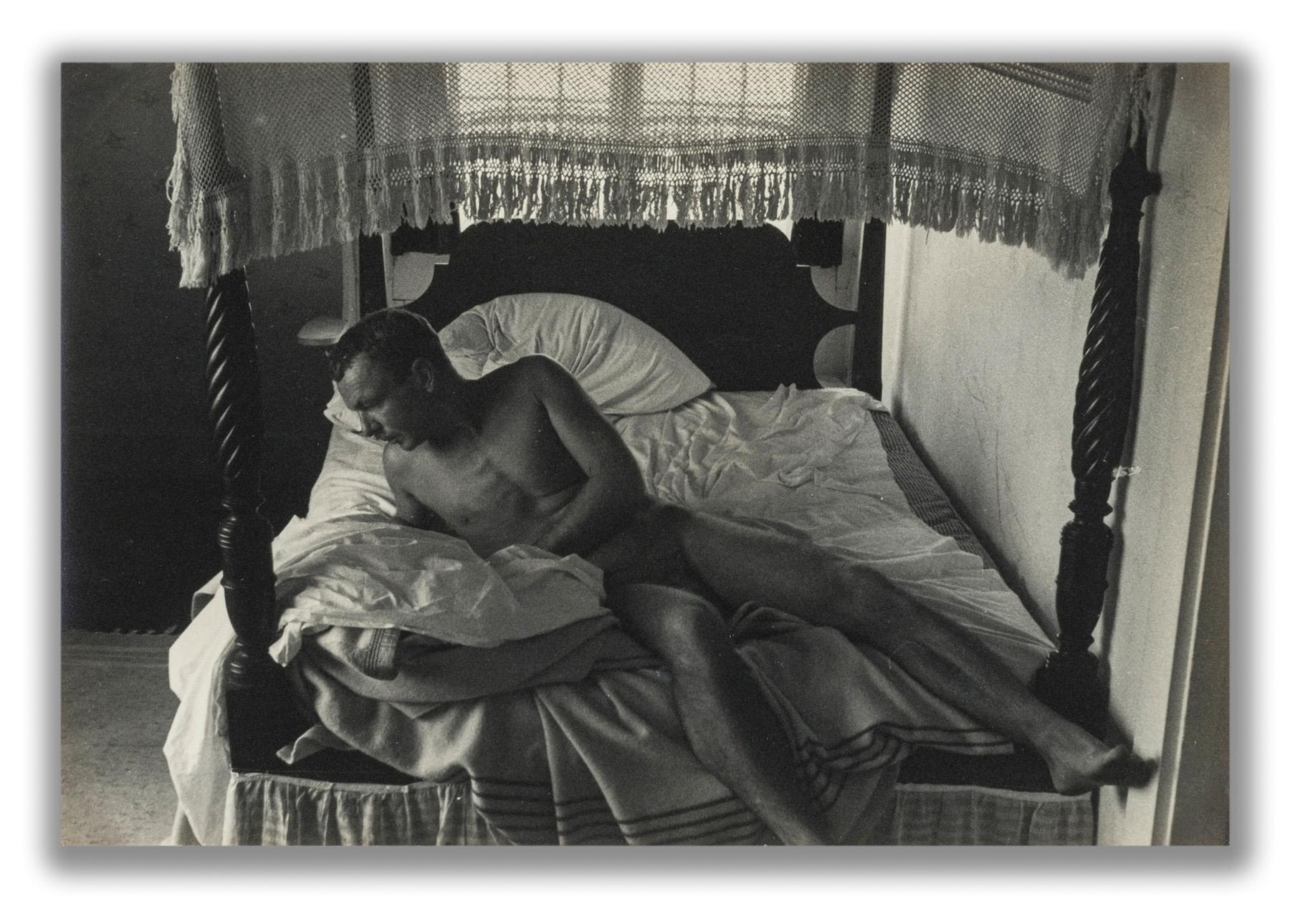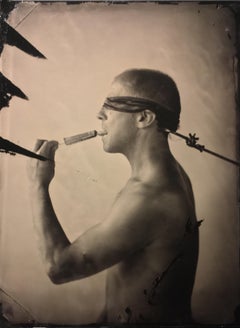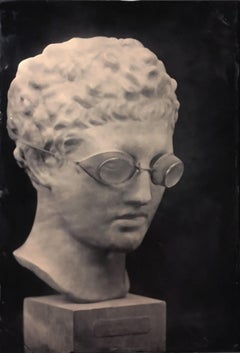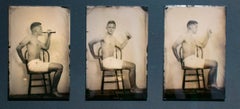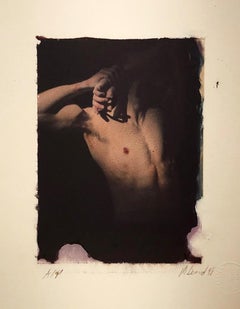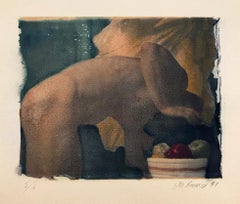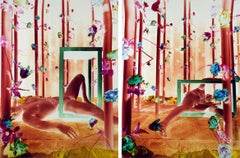
Nathan With Rope (Figurative Tin Type Photograph of Male Nude in Vintage Frame)
View Similar Items
David SokoshNathan With Rope (Figurative Tin Type Photograph of Male Nude in Vintage Frame)
About the Item
- Creator:
- Dimensions:Height: 15.25 in (38.74 cm)Width: 13 in (33.02 cm)Depth: 3 in (7.62 cm)
- Medium:
- Period:
- Condition:
- Gallery Location:Hudson, NY
- Reference Number:1stDibs: LU2274688562
David Sokosh
David Sokosh, has long held a fascination with vintage technologies and aesthetics. In addition to his other interests, it’s no surprise that Sokosh favors the 19th century photographic process of Wet Plate Collodion in his own image making. Sokosh uses an authentic Victorian lens fitted to a handmade camera to photograph staged scenes in a daylight studio in Claverack, NY. His tintypes are a far cry from geeky to sophisticated still-lifes are mixed with contemporary subject matter. But no matter the contents, each photograph is veiled with the illusion of time past. All plates are unique, however, he occasionally will photograph the same subject several times to mimic multiples.
- Linguist (Salacious Tin Type Photo of Male Nude Licking an Ice Pop, blindfolded)By David SokoshLocated in Hudson, NYSuggestive Contemporary Tin Type Photograph of Male Nude by David Sokosh Wet plate collodion on aluminum, unique 12 x 9 inch aluminum plate, 21 x 17 x 1 inche...Category
2010s Contemporary Figurative Photography
MaterialsPhotogravure
- Hermes with Goggles On (Tin Type Triptych of Statue, Vintage Victorian Frame)By David SokoshLocated in Hudson, NYPause that Refreshes (Vintage Tin Type Triptych of Young Man Drinking Coca Cola) Wet plate collodion on aluminum, unique Panel is 6 x 4 inches, 15.5 x 13.5 in...Category
2010s Contemporary Figurative Photography
MaterialsPhotogravure
- Pause that Refreshes (Vintage Tin Type Triptych with Coca Cola)By David SokoshLocated in Hudson, NYPause that Refreshes (Vintage Tin Type Triptych of Young Man Drinking Coca Cola) Wet plate collodion on aluminum, unique Triptych, each panel is 6 x 4 inches ...Category
2010s Contemporary Figurative Photography
MaterialsPhotogravure
- Male Nude with Head Down (Sepia Toned Figurative Photograph by David Halliday)By David HallidayLocated in Hudson, NYContemporary figurative sepia toned photograph of nude male model Sepia toned silver gelatin print, edition 3 of 25 Image size: 8 x 8 inches 17.5 x 16.5 x 1 inches framed with 8-ply ...Category
1990s Contemporary Figurative Photography
MaterialsSilver Gelatin
- Untitled 13 (Mark Beard Polaroid Transfer of Young Male Nude on Rives BFK)By Mark BeardLocated in Hudson, NYimage size: 10 x 8 inches Young male sitting against dark background Polaroid Transfer on 22 x 15 inch Rives BFK paper, unframed signed SM Beard in pencil on bottom right corner. ed...Category
1990s Contemporary Nude Photography
MaterialsPolaroid, Archival Paper
- Winged: Sepia Toned Photograph of Male Nude Portrait by David Halliday, FramedBy David HallidayLocated in Hudson, NYWinged: Sepia Toned Figurative Photograph of Nude Male by David Halliday, Framed Contemporary, horizontal figurative sepia toned photograph Sepia toned silver gelatin print, edition ...Category
1990s Contemporary Figurative Photography
MaterialsSilver Gelatin
- Untitled (Male Nude in Shadow)By Mark BeardLocated in New York, NYPolaroid transfer on Rives BFK paper Signed, dated, and inscribed (AP) in pencil, recto Also blindstamped, l.r. 22 x 15 inches, sheet 10 x 8 inches, image This artwork is offered b...Category
1990s Other Art Style Figurative Photography
MaterialsPhotogravure
- Untitled (Stooped Man with Bowl of Fruit)By Mark BeardLocated in New York, NYPolaroid transfer on Rives BFK paper Signed, dated, and numbered (5/6) in pencil, recto Also blindstamped, l.r. 22 x 15 inches, sheet 8 x 10 inches, image This artwork is offered b...Category
1990s Other Art Style Figurative Photography
MaterialsPhotogravure
- Untitled (Figure Diptych)By Robert CalafioreLocated in New York, NYTwo pinhile camera Chromogenic prints (Unique) Signed and dated, verso 40 x 30 inches, each print 40 x 60 inches, overall This artwork is offered by ClampArt, located in New York C...Category
2010s Contemporary Figurative Photography
MaterialsC Print
Price Upon Request - Mel FelliniBy George Platt LynesLocated in London, GBSilver gelatin print, studio stamp (verso), 20cm x 23cm, (45cm x 46cm framed). The photographed behind museum quality, UV and non-reflective glass. A titan of American 20th century photography, Platt Lynes took his first photographs as a young artist living in New York and Paris in the 1920s. He maintained an interest in the male figure throughout his career and was part of a close-knit group of artists, including Paul Cadmus, Jared French, Margaret French...Category
1950s American Modern Nude Photography
MaterialsSilver Gelatin
- Bowling FantasyBy Arthur TressLocated in London, GBSilver gelatin print, studio stamp (verso), 19cm x 19cm (print size), (50cm x 40cm in mount), unframed, but contained within archive quality mount. Tress is one of the most renowned and innovative photographers of his generation. Citing his influences as Hokusai, Frank Lloyd Wright, Picasso, El Lissitzky, Duane Michaels...Category
1970s Surrealist Nude Photography
MaterialsSilver Gelatin
- `Psycho`, Okurimono series, Tokyo- japan-nude -harajuku-girl-colorBy Christian HougeLocated in Oslo, NOOkurimono Pigment Print Images from the Okurimono series is available in 3 different formats : * 50 x 75 cm : edition of 10 + (+2ap) * 80 x 120 cm : edition of 7 + (+2ap) * 113 x 170 cm : edition of 7 + (+2ap) Each print is numbered and signed About the work : Work by contemporary photographer Christian Houge, from the Okurimono series. In this series, Houge has, through five trips to Japan (Tokyo, Osaka and Kyoto), explored Japans otherworldly subculture and its ritualistic perfection. In this personal art documentary he has ventured into delicate themes such as personal identity, sexuality, longing and gender dysphoria. In this particular series, he uses staging as a method to create a story within a story. The viewers associations are important in meeting this work and ambiguity plays an important role. In this series, Houge has, through five trips to Japan (Tokyo, Osaka and Kyoto), explored Japans otherworldly subculture and its ritualistic perfection. In this personal art documentary he has ventured into delicate themes such as personal identity, sexuality, longing and gender dysphoria. In this particular series, he uses staging as a method to create a story within a story. The viewers associations are important in meeting this work and ambiguity plays a Okurimono (meaning both “gift” and “that which is in-between” in Japanese) - is a word that binds together this comprehensive project developed over five trips to Japan between 2007 and 2018. The series explores the personal pursuit of identity, at times with an underlying darkness as Houge had the chance to be introduced to Tokyo’s subculture. In exploring this theme, Houge has ventured into delicate matters such as sexuality, longing and gender dysphoria. In this particular series, he uses staging as a method to create a story within a story. The artist wishes to question the viewer and provoke a reflection on topics that are often seen as taboos in our contemporary societies. The viewer’s own associations are important in appreciating this work where ambiguity plays an important role. The project started in the Harajuku district of Tokyo which is known as a center of Japanese youth culture and where Houge found some of his first motifs: teenage girls dressing up in post-Victorian dresses or ‘cosplay’ costumes to identify with a character of their favorite comics. Here, the desire to express one’s uniqueness is central and the photographer explores the tension between personal identity and aesthetics shared by all (or at least by the same youth group). In many of his carefully staged photographs, Houge’s models are masked, so as to echo the many social masks we wear in our day-to-day lives. In our post-modern information society, drained of wonder, these enigmatic masked characters also evoke the world of shamans and pagan rituals, therefore injecting a sense of mystery and spirituality that many people are longing for. Symbolism and the many references to ritual and identity in an otherwise suppressed society, may at times create a sense of unease among viewers. The Okurimono project also explores the topic of identity and sexuality in gender dysphoria with Japan’s nyūhāfu (the transsexual ‘new halfs’). Here, the quest for identity coincides with a search of femininity and body image which results in complex physical transformations. Viewers may look at these portraits not having any clue that models are nyūhāfu. Yet, the photographs are staged so that viewers are placed in a disconcerting voyeuristic role while looking at otherwise closed world. Shibari (the art of tying), which originates from the Edo period (1600s), is another territory explored by Houge in his Okurimono series. His striking photographs of female models tied with red rope on a white background take us into this powerful journey into vulnerability and surrender, power and freedom. Through tradition, symbolism and technology, Okurimono also explores the hugely potent symbols that help define parts of Japanese culture and national identity, between old and new. As Art historian Erling Bugge put it: “Christian Houge guides us into a mystery. It resides between the ritualized shapes of the traditional and withdrawn Zen garden in Kyoto and the equally ritualized spaces of futuristic, urban Tokyo. For a westerner, Japan might look familiar, since what is held up for us looks like a futuristic spectacle somehow grounded in a western imagination. This judgment, however, is too easy. In Houge’s photographs, the sense of sameness withdraws and a very different feeling of strangeness creeps up on us. In fact, what this series registers is a remarkable place of alterity in today’s global order, a radical difference bang in the middle of the familiar.” The images of the Okurimono series share a ghostly, otherworldly quality. In reality and dream, ritual and play merge while the boundaries between the known and the unknown dissolve. Christian Houge – Now – Okurimono Christian Houge guides us into a mystery. It resides between the ritualized shapes of the traditional and withdrawn Zen garden in Kyoto and the equally ritualized spaces of futuristic, urban Tokyo. For a westerner, Japan might look familiar, since what is held up for us looks like a futuristic spectacle somehow grounded in a western imagination. This judgment, however, is too easy. In Houge’s photographs, the sense of sameness withdraws and a very different feeling of strangeness creeps up on us. In fact, what this series registers is a remarkable place of alterity in today’s global order, a radical difference bang in the middle of the familiar. This is pushed to the limit in the technological and virtual wonderland of Akihabara in Tokyo, where shop after shop trade in electronic products and computer games, while a weird costume play, “cosplay”, is being performed in streets. A similar kind of simulation is being acted out in the district of Harajuku, where Houge found some of his motifs. There is no authenticity here, no western “essence” or “reality”; instead, the virtual conquers the carnal body in a purified play of surface, image and the hyperreal. This is exotic. All the while as we are conscious of these notions as pinnacle points in a western idea of the post-modern. But in this sense Japan has always been “post-modern”. It has always integrated the most refined culture and technology from the outside while somehow retained an identity for itself. So, what would this identity be? Houge takes the view of ritual and play. Indeed, Japanese culture seems to be grounded solely on ritual, in business and in sex, in its relation to nature and in religion. This play transcends the notion of authenticity altogether, unlike the West which is haunted by the “ghost” of origin and beginnings. In Japan, “now” would mean just that; it is a “no looking back”, but rather a flow of intensities integrated in the play and ritual of the ever-present, okurimono. There is no threat of being eaten up by western culture and technology here, for, like in Zen practice, the ritual oversees everything and has no historical drag. Japan becomes weightless, shot into orbit outside the material of earth itself. Is acting out the role as Lewis Caroll’s Victorian girl driven by a sense of nostalgia? I think not. It is a striving for a moment of perfected presence, in dialogue with Houge’s optical machine. It is the moment of Now. The girl, the Zen garden and the image shares in a perfection modified by small uncertainties, coincidental imperfections that become somewhat oblique points of entry for us - a discarded handkerchief or seemingly unremarkable shapes and reflections in the prismatic play of surfaces. There is a ghostly, otherworldly quality in these images, even in the fleeting blossoming cherrytree and the play of shadows across a concrete minimalism. The doubly exposed or reflected light on the lens reminds us of the uncertain beginnings in photography’s history, with its widespread belief that the camera was able to perceive more than the naked eye, like spirits and ghosts. In Houge’s images there are different specters, skeletal, natural shapes on the one hand, the machine and the virtual on the other. Here, like some scene from the film Blade Runner, there is an uncanny confusion and mix between the human and non human. Maybe the search for a perfect moment in the perpetual flow of things is a romantic or melancholic longing for transcendent wholeness, a drive that is harnessed in a rigorous attention to visual detail. This compulsive discipline might seem absurd to any western observer, while longing itself form a common ground and will ultimately be the basis in our meeting. Erling Bugge Bio: Christian Houge (born in Oslo 1972) Based in Oslo, Norway, I have been making photographs for over twenty years and new insights continue to open. By exploring the relation, and conflict, between Nature and culture, I get a better understanding about Mans` condition. I am interested in the consequences of Humankinds progression and how science often is the result of our conquering of Nature, both on Earth and beyond. Mans` ego, consumer society, the last remnants of pure Nature and identity are recurring elements in my work. I often juxtapose the visually aesthetic with an underlying uneasiness. This often emanates a cognitive dissonance in the viewer to invite deeper truths and personal references. Looking at our actions and place in environment, which we are so dependent on, is a recurring theme in all my exploration and can use everything from digital cameras to large format and panoramic analog cameras for specific projects. I have exhibited extensively in galleries and museums in my native country Norway, as well as the US, England, France and China. The series `Death of a Mountain`(2016-2021) is nominated for the 2021 Leica Oskar Barnack Award, as well as receiving an arts grant from Norwegian Arts Council. Most recently, my series `Residence of Impermanence` 2017-2019 has been exhibited at five museums and several galleries already (including a solo show at Fotografiska, Stockholm (2019), and Les Recontres d`Arles, Haugar Artmuseum, Preus Muaeum of Photography and 2019 (Galerie Omnius, Arles). In 2021, this series received ten nominations for the Prix Pictet Award with the theme FIRE. `Residence of Impermanence` is currently exhibited at the UCR: California Museum of Photography in Los Angeles with the exhibition `Facing Fire,` Art, Wildfire and The End of Nature in the New West...Category
2010s Nude Photography
MaterialsDigital Pigment
